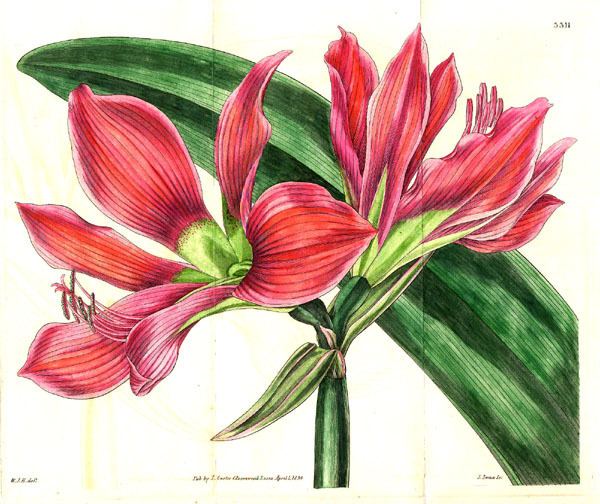Clade Monocots Rank Subtribe | Clade Angiosperms | |
 | ||
People also search for Hippeastreae, Hippeastrum, Griffineae | ||
Hippeastrinae is a subtribe of plants classified under the tribe Hippeastreae. It belongs to the subfamily Amaryllidoideae of the Amaryllis family (Amaryllidaceae).
Contents
Description
Terrestrial bulbous perennial herbaceous plants, although three species of Hippeastrum are epiphytic. The leaf shape is linear, lorate, or lanceolate (Eithea has oblanceolate-petioled leaves). The leaf growth pattern is annual or persistent, and often histeranthous. Their texture is firm, and they are moderately canaliculated internally. The scape is hollow and the spathe has two bracts which may be fused or free.
The inflorescence may have between one and thirteen flowers. The flowers, which may be sessile or pedicellate have a perigone that is actinomorphic to highly zygomorphic, and is tubular, campanulate or infundibulorm in shape. The tepal-tube may vary from obsolete to being more than half the length of the perigone. When a paraperigone is present it consists of basal appendages that are diminutive, membranous, bristle-like, and forming a fimbriate-lacerate or callose ring, partly adnate to the throat of the perigone, surrounding the fascicle of the stamen.
The stamen filaments are filiform and either declinate-ascending or straight and arranged in two to four series ( 2- or 4-seriate). The stigma is usually either trifid or obscurely trilobed, but some taxa (Famatina herbertiana, Tocantinia mira, and certain Hippeastrum species) have a capitate stigma. The style is either declinate or straight. Chromosome number: 2n = 12–60.
Taxonomy
As formulated on morphological grounds alone it included six genera: This included species of medium height and often with many flowers in each inflorescence and inflorescence bracts are different in size and fused basally. The alternative spelling Hippeastrineae was also used by some authors.
As reformulated using molecular phylogenetics it included seven to eight genera (Famatina is uncertain). In this redistribution the four species of Famatina were polyphyletic and F. maulensis segregated with Phycella and was consequently placed in Traubiinae, while the remaining three segregated with Rhodophiala and are considered here. However none of the identified genera were monophyletic. Some subclades were supported, such as the core-Rhodophiala (Rhodophiala excluding R. bifida but including some Famatina).
The genera and (species) are as follows:
Formerly included, now subtribe Traubiinae:
Distribution
Mainly subtropical and tropical regions of South America, the Greater Antilles, Mexico, and the southern United States. Core-Rhodophiala species are distributed in Mediterranean Chile, including the lowlands and high-Andes as well as high Andean areas of Argentina, and also the Atacama Desert.
